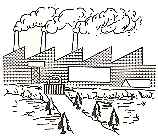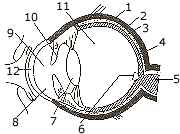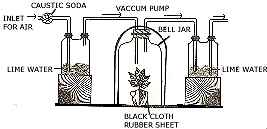(Biology) ICSE Class X Important Questions : Biology (1996)
Disclaimer: This website is NOT associated with CBSE, for official website of CBSE visit - www.cbse.gov.in
Paper : ICSE Class X Important Questions : Biology (1996)
General Instructins
-
Attempt all questions from Section I and any four questions from Section II.
-
The intended marks for questions or parts of questions are given in brackets.
SECTION
I (40 Marks)
Attempt all questions from this Section.
Question 1
(a) Name the following: [8]
-
The respiratory pigment contained in human blood.
-
The process by which raisins swell up when placed in a beaker of water.
-
The blood vessel that supplies oxygenated blood to the liver.
-
An organism which helps in nitrogen fixation.
-
The paper which is used to show loss of water through stoma of a leaf .
-
The process by which leucocytes squeeze out through walls of capillaries.
-
The cells of the retina that are sensitive to colour.
-
The organ in which the foetus develops in a mammalian female.
(b) Complete the following statements by choosing the correct alternative out of the given in brackets: [6]
-
The human kidney is made up of millions of ...............
( Neurons/ Bowman's capsules/ Nephrons) -
Fertilization of the human egg normally occurs in the ............. (Uterus/ Fallopian tube/ Vagina)
-
Loss of water as droplets through leaves of an intact plant is termed .............. (Bleeding/ Guttation/ Transpiration)
-
During the process of expiration in man the diaphragm remains..............
(Flattened/ Convex towards abdominal cavity/ Convex towards thoracic cavity) -
The wall of the heart is made up of .....................
(Striated muscle/ Voluntary muscle/ Cardiac muscle) -
Penicillin obtained from a fungus is an ..................
(Antiseptic/ Antibody/ Antibiotic)
(c) State whether the following statements are True or False. If false, rewrite the statement in its correct form by changing the first or last word only. [6]
-
The energy currency of the cell is D.NA.
-
Zygote is the product of fusion of male and female gametes.
-
Low humidity in the atmosphere results in a decrease in the rate of transpiration.
-
Tubectomy involves the cutting and tying of the vas deferens in male.
-
Hypermetropia is a defect of the eye caused due to the eyeball being elongated.
-
W.H.O procures and provides blood to victims of war.
(d) The figure given below shows one of the causes of air pollution: [8]

-
What is meant by air pollution?
-
The exhaust from these chimneys contain H2SO4 etc. as pollutants. Mention one harmful effect of each of the above
pollutants either to man or to the environment. -
Mention. any two harmful effects of noise pollution.
(e) Give one point of difference between the following on the basis of what is within brackets. [6]
-
Aerobic and Anaerobic respiration. (End products of glucose molecule)
-
Red blood corpuscle and white blood corpuscle. (Function)
Cerebrum and spinal cord. (Arrangement of neurons)
(f) The diagram given alongside represents the cross-section of the human eye: [6]

-
Name the parts labelled 1 to 12.
-
What is the function of the part marked '10'?
-
What would happen if part '5' is damaged or cut?
SECTION II
(40 Marks)
Answer any four questions from this section.
Question 2
(a) The apparatus arranged below signifies an important process. [5]

-
Name the process
-
Where does this process occur in plants?
-
What solution is placed inside the dialysis tubing?
-
What happens to the level of the solution in the capillary tube?
-
Define the process mentioned in Q. 'i' above.
Question 2
(b) [5]
-
What is meant by 'reflex action'? Mention any two examples of reflex action occurring in day-to-day life.
-
Mention two functions of W.H.O.
Question 3
(a) A potted destarched plant was taken in order to prove that light is
necessary e for photo-synthesis: [5]
-
What is meant by destarched plant? How can it be destarched?
-
Using the destarched plant describe step by step how you would proceed to prove that in the absence of light the leaf cannot manufacture.
(b) Given diagram is the external features of the heart. [5]

-
Name the parts '1' to '7'.
-
What happens if the coronary artery gets an internal clot?
-
What type of blood does '5' carry?
-
Mention one structural difference between '5' and '4'
Question 4
(a) Given below is an experiment set up to demonstrate a phenomenon in plants:
[5]
-
What is the aim of this experiment?
-
Why was the bell jar covered with black cloth?
-
What is the purpose of caustic soda?
-
Give an overall chemical equation of the process mentioned in Q 'i' above.

(b)
-
Draw a labelled diagram of the human kidney as seen in a longitudinal section.
-
Name the hormones produced by the following glands. In each case state one function the hormone. 1. Thyroid 2. Pancreas 3. Adrenal medulla [5]
Question 5
(a) The diagram shown alongside is an apparatus used to study a particularil
phenomenon in plants: [5]

-
Name the apparatus.
-
What is it used for?
-
What is the role played by the air-bubble in this experiment?
-
Of what use is the reservoir?
-
What happens to the movement of the air-bubble if the apparatus is kept:
a. in the dark
b. in sunlight 3. in front of a fan?
Give a reason in each case.
(b) [5]
-
Draw a diagram of the human sperm and label the following parts:
Head, middle, piece, acrosome, mitochondria, tail. -
Define the following terms:
a. Vaccination;
b. Death rate; 3. Hormones.
Question 6
(a) The diagram below represents parts of the human ear: [5]

-
Name the parts labelled '1' to '8'.
-
What is the function of the parts marked '2' and '7'?
-
Why is it harmful to use a pin or any sharp object to remove the wax from the ear?
(b) Describe briefly the fuctions of any five of the following: [5]
-
Alveoli;
-
Palisade parenchyma;
-
Antiseptic
-
Medulla Oblongata;
-
Placenta in mammals;
-
Testis.
Question 7
Write brief statements explaining any five of the following: [10]
-
People living in hilly regions usually suffer from simple goitre.
-
Why resources cannot keep pace with the rising population? Give examples.
-
Most often only one embryo is formed at a time although there are two ovaries in women.
-
Strips of potato placed in 50% sucrose solution appear soft and shrivelled.
-
It is advisable to breathe through the nose and not through the mouth.
-
Insulin is injected into the body of a highly diabetic patient and not given orally.